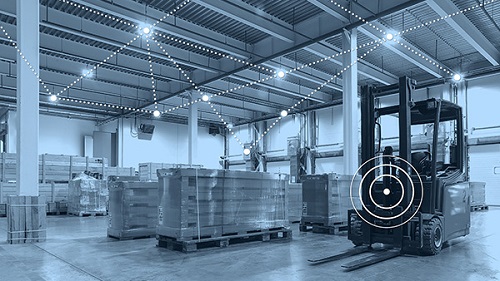

Wired lighting infrastructures have a history of providing dependability that, until recently, wireless networks couldn’t match.
And while there are other benefits to installing a wired network, many of today’s wireless platforms—especially those supported by a Bluetooth® mesh network—ensure greater flexibility and extensibility at a reduced cost.
Wired vs Wireless
Advancements in wireless connectivity make it hard to justify choosing a wired infrastructure over a wireless platform. An argument could be made that wired networks still offer better reliability, but installation costs, for both materials and labor, are significantly higher. On top of the added expense, there’s also a greater chance of disruption to day-to-day operations when deploying or upgrading a wired system, especially in highly active commercial or industrial environments. A wireless network provides significant cost savings with minimal disruption during deployment.
Additionally, a wired network is a concrete part of a building’s infrastructure and does not scale easily. Upgrades often require new component installs to improve performance, and in some cases, an entire rip and replace of the existing system is necessary. Wireless platforms are easier to install and upgrade, offering the flexibility you need to respond quickly to changing business demands.
Commercial Lighting and Bluetooth Technology
A wireless platform supported by a Bluetooth mesh network allows a system, such as lighting, to provide additional capabilities beyond its primary use, offering greater overall value and ensuring a higher return on investment. “It may be necessary to integrate a lighting system with various types of sensors in the building,” said Martin Wooley, technical program manager, Bluetooth Special Interest Group (SIG). “It’s possible to achieve this with wired systems, but often this requires separate control equipment to orchestrate sensor and lighting behaviours. Bluetooth mesh was designed to address problems of this sort…, specifically with commercial lighting systems in mind.”
Bluetooth mesh networking is a full-stack solution designed for commercial lighting applications and includes features specific to a wireless lighting platform. In James O Malley’s recent Gizmodo UK article outlining six reasons why Bluetooth mesh will make a big impact, he talks about the versatility of a Bluetooth mesh network when used for lighting. Malley explained, “…if you have a home or a workplace where every light-bulb is Bluetooth enabled, this doesn’t just mean you have smart lighting… you have in fact built a building-wide Bluetooth network blanket, which can talk to every other Bluetooth device in the building.”
In addition to supporting common lighting requirements, a Bluetooth mesh network can include fully integrated non-lighting features, such as sensors. In Wooley’s technical paper, Bluetooth Mesh Networking: Paving the Way for Smart Lighting, he illustrates examples of lights that can act as Bluetooth beacons, allowing smartphone apps to help visitors find their way around a building. Or a lighting system that can collect a range of data from building sensors, making it available for analysis and real-time use.
“The more interesting and potentially substantial opportunity, which a Bluetooth mesh lighting system offers, is that installing such a system equips the building with a wireless network and creates a distributed platform for other wireless building services,” said Wooley. “Lights and switches are microcontrollers with a Bluetooth mesh communications capability and software which controls what those devices can do. Software can be upgraded and added to, so new capabilities…can reside within the lighting system.”
Designed with Lighting in Mind
The Bluetooth mesh network specification provides an innovative wireless solution for commercial lighting. It offers reliability that is functionally equivalent to that of a wired system, but with the added responsiveness, scalability, and extensibility that you can only get from a wireless solution. "Bluetooth mesh networking is the most robust and powerful low-power radio technology for connected lighting in commercial spaces,” said Rafal Han, CEO, Silvair.
Combine that with the multi-vendor interoperability, low power, and low latency of a Bluetooth Low Energy (LE) stack, and you get a comprehensive lighting system that also serves as an industrial-grade platform for distributed wireless building services. This enhances operational efficiency and creates a flexible network infrastructure that can adapt to changing business needs.
Copyright 2006-2025 Shanghai Sinoexpo Informa Markets International Exhibition Co., Ltd. All rights reserved